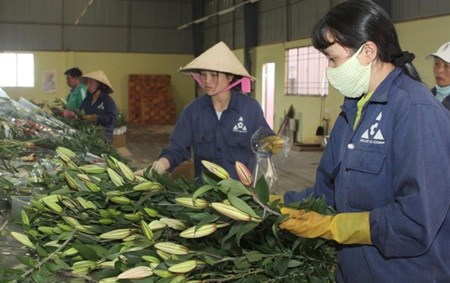Flower industry needs tech growth
 Workers package flowers at Rung Hoa Biotechnology Joint Stock Company in Lam Dong province's Da Lat City (Source: VNA)
Workers package flowers at Rung Hoa Biotechnology Joint Stock Company in Lam Dong province's Da Lat City (Source: VNA)
HCM City (VNA) – Both local and foreign experts have urged Vietnamese flower growers to cultivate new kinds of flowers and use high-tech planting techniques to develop the industry.
Pham Van Hai, CEO of Vietnam Trade International, said: "The city of Sa Dec in Dong Thap province, which is one of the country's flower cities, has developed slowly compared to its potential as many farmers have not used advanced technology in cultivation."
Speaking at a conference held in HCM City in early February, he said demand for flowers had surged for special occasions like Valentine's Day, International Women's Day, Vietnam Teacher's Day and Lunar New Year.
Dr Nguyen Duc Tri, Dean of the School of Tourism under the HCM City University of Economics, said that flowers in the past were used primarily for use at altars honouring ancestors.
Hai said that to develop a stable domestic flower market, new types of flowers and application of advanced cultivation techniques were needed.
Cooperation with other countries, such as the Netherlands, which is a major flower producer, would be important, Hai said.
Such cooperation would help farmers learn new techniques.
"When the country has a stable and diverse, as well as high quality, flower market, the proportion of flowers exported to other markets such as Japan, Taiwan, Korea, Singapore and Hong Kong will increase," he said.
Vietnam's flower growing area of about 8,000 hectares yields 4.5 billion fresh-cut branches, of which 1 billion were rose, daisy and orchid for export each year.
Hanoi, Hai Phong and Lam Dong provinces produce the highest number of flower branches.
Da Lat in Lam Dong province is the country's biggest flower producer and exporter, annually providing 10 million saplings for domestic and foreign markets.
The biggest import markets include China, which imports flowers from Da Lat, such as roses, lily and orchids, and Japan, whose customers are fond of lotus flowers.
In 2014, the total value of flower exports to Japan was 22 million USD.
The Netherlands imports many kinds of Vietnamese flowers to export to other countries.
Singapore, Australia, and Saudi Arabia also import flowers from Vietnam.
The main challenge of the flower industry in Vietnam is distribution, according to Tri.
Though leading flower producers use refrigerated shipping services to preserve seedlings and bulbs, smaller companies and farming families cannot afford to send their flowers to market this way.
As a result, their produce can deteriorate during transportation.
Hai added that flowers were transported from Mekong Delta provinces, such as Sa Dec in the Delta to HCM City, by small boats.
Trucks were used to transport flowers from Da Lat to the city, he said.
About 22 percent of flowers were spoiled by the time they reach the city, he added.
"Flower preservation via shipping in the country is not good," he said.
His company has urged growers in the Netherlands to build two flowers distribution centres in Sa Dec and Da Lat. These would help reduce damage in shipping, Hai said.
The centres would also ensure markets for farmers, he said.
Tourism could also benefit from a more advanced flower industry, especially activities related to flower villages.-VNA













